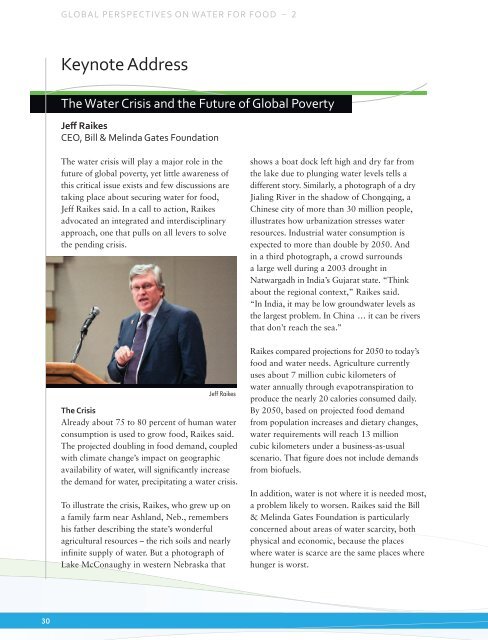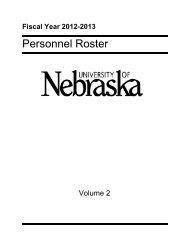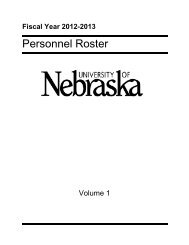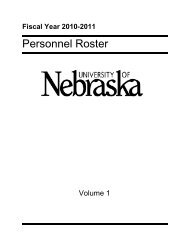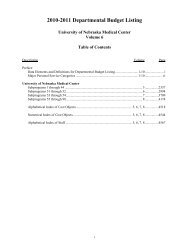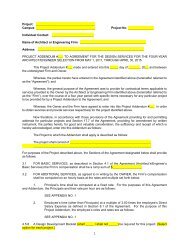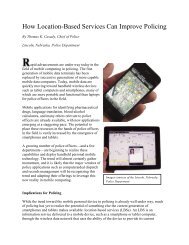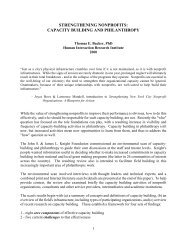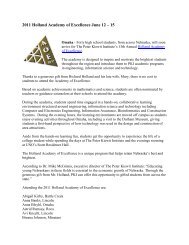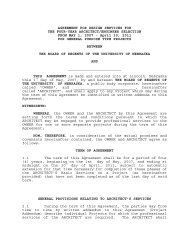Full Version - Water for Food Institute - University of Nebraska
Full Version - Water for Food Institute - University of Nebraska
Full Version - Water for Food Institute - University of Nebraska
Create successful ePaper yourself
Turn your PDF publications into a flip-book with our unique Google optimized e-Paper software.
30<br />
GLOBAL PERSPECTIVES ON WATER FOR FOOD 2<br />
Keynote Address<br />
The <strong>Water</strong> Crisis and the Future <strong>of</strong> Global Poverty<br />
Jeff Raikes<br />
CEO, Bill & Melinda Gates Foundation<br />
The water crisis will play a major role in the<br />
future <strong>of</strong> global poverty, yet little awareness <strong>of</strong><br />
this critical issue exists and few discussions are<br />
taking place about securing water <strong>for</strong> food,<br />
Jeff Raikes said. In a call to action, Raikes<br />
advocated an integrated and interdisciplinary<br />
approach, one that pulls on all levers to solve<br />
the pending crisis.<br />
Jeff Raikes<br />
The Crisis<br />
Already about 75 to 80 percent <strong>of</strong> human water<br />
consumption is used to grow food, Raikes said.<br />
The projected doubling in food demand, coupled<br />
with climate change’s impact on geographic<br />
availability <strong>of</strong> water, will significantly increase<br />
the demand <strong>for</strong> water, precipitating a water crisis.<br />
To illustrate the crisis, Raikes, who grew up on<br />
a family farm near Ashland, Neb., remembers<br />
his father describing the state’s wonderful<br />
agricultural resources – the rich soils and nearly<br />
infinite supply <strong>of</strong> water. But a photograph <strong>of</strong><br />
Lake McConaughy in western <strong>Nebraska</strong> that<br />
shows a boat dock left high and dry far from<br />
the lake due to plunging water levels tells a<br />
different story. Similarly, a photograph <strong>of</strong> a dry<br />
Jialing River in the shadow <strong>of</strong> Chongqing, a<br />
Chinese city <strong>of</strong> more than 30 million people,<br />
illustrates how urbanization stresses water<br />
resources. Industrial water consumption is<br />
expected to more than double by 2050. And<br />
in a third photograph, a crowd surrounds<br />
a large well during a 2003 drought in<br />
Natwargadh in India’s Gujarat state. “Think<br />
about the regional context,” Raikes said.<br />
“In India, it may be low groundwater levels as<br />
the largest problem. In China … it can be rivers<br />
that don’t reach the sea.”<br />
Raikes compared projections <strong>for</strong> 2050 to today’s<br />
food and water needs. Agriculture currently<br />
uses about 7 million cubic kilometers <strong>of</strong><br />
water annually through evapotranspiration to<br />
produce the nearly 20 calories consumed daily.<br />
By 2050, based on projected food demand<br />
from population increases and dietary changes,<br />
water requirements will reach 13 million<br />
cubic kilometers under a business-as-usual<br />
scenario. That figure does not include demands<br />
from bi<strong>of</strong>uels.<br />
In addition, water is not where it is needed most,<br />
a problem likely to worsen. Raikes said the Bill<br />
& Melinda Gates Foundation is particularly<br />
concerned about areas <strong>of</strong> water scarcity, both<br />
physical and economic, because the places<br />
where water is scarce are the same places where<br />
hunger is worst.


